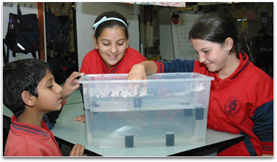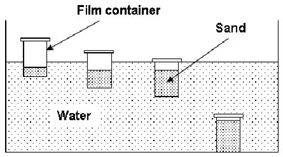This focus idea is explored through:
Contrasting student and scientific views
 Students have frequent experiences with objects floating and sinking in the bath, in a swimming pool or at the beach. They form understandings from an early age about these ideas and equally importantly the words used to describe them.
Students have frequent experiences with objects floating and sinking in the bath, in a swimming pool or at the beach. They form understandings from an early age about these ideas and equally importantly the words used to describe them.
Students tend to pay little attention to why things float or sink and may perform simple tests on objects in a tank of water without any understanding of the forces involved in why they float or sink. These can be quite challenging to identify and understand.
Students commonly believe that:
- heavy objects sink and light objects float regardless of their size, shape or the type of material used to make them
- a true floating object must be wholly above the surface of the liquid
- all objects that float must contain some trapped air and that is the only reason why they float
- the amount of liquid on which the object floats matters somehow, i.e. an object will float higher in a larger volume or deeper liquid.
Research:
Biddulph & Osborne (1984),
Mitchell & Keast (2004)
Scientific view
An object floats when the
weight force on the object is balanced by the upward push of the water on the object. The upwards push of the water increases with the volume of the object that is under water; it is not affected by the depth of the water or the amount of water.
If the weight force down is larger than the upward push of the water on the object then the object will sink. If the reverse is true then the object will rise – rising is the opposite of sinking.
Different objects float at different levels in the water because as most regular objects are lowered into the surface of water, the upward push of the water steadily increases until it is in balance with the weight force of the object, and the object then continues floating at this level with the two forces in balance.
Many objects that are hollow (and so generally contain air) float because the hollow sections increase the volume of the object (and so the upwards push) for very little increase in weight force down. However, it is not necessary for an object to contain air in order to float.
No object can float without some part of it being below the surface of the water.
Critical teaching ideas
- To float, the weight force on an object must be balanced by the upward push by the water on the object.
- The amount of material and the type of material that makes up the object affects the size of the weight force on the object.
- The volume of the object, which can often be altered by changing the shape, will affect the size of the upward push on the object.
 Explore the relationships between ideas about floating and sinking in the
Concept Development Maps: Laws of Motion
Explore the relationships between ideas about floating and sinking in the
Concept Development Maps: Laws of Motion
Students will be familiar with the idea that objects have weight and that the size of the weight force is determined by the type of material and how much of it is used to make up the object.
Students should learn that when an object floats the water is pushing upwards on the object. For example, when you try to push a surfboard under the water you can feel the water pushing the board up. Objects such as rocks that have sunk, are still experiencing an upwards push; it is just not as strong as the weight force.
Students should be encouraged to view floating as being a result of the balance of the weight force on an object and the upward push of the water on the submerged part of the object.
Students should be guided to recognise that changing the shape of an object:
- does not change the weight of the object
- can change the volume of the object.
Research:
Carr, Barker, Bell, Biddulph, Jones, Kirkwood, Pearson & Symington (1994)
Teaching activities
Provide an open problem for students to explore via play
 At this level it is appropriate for students to experiment with a variety of objects to see if they float or sink in water. They should be encouraged to identify common characteristics of objects that float and those that sink. Students can try submerging a ball in a bucket of water in order to feel the upward push of the water on the ball. A more quantitative approach could involve measuring the weight of different objects to see whether that affects how they float or sink in water. Students could experiment with different sized objects with the same weight to see how this influences their floating.
At this level it is appropriate for students to experiment with a variety of objects to see if they float or sink in water. They should be encouraged to identify common characteristics of objects that float and those that sink. Students can try submerging a ball in a bucket of water in order to feel the upward push of the water on the ball. A more quantitative approach could involve measuring the weight of different objects to see whether that affects how they float or sink in water. Students could experiment with different sized objects with the same weight to see how this influences their floating.
Encourage students to experiment with little sealable containers such as empty film containers to see if they float, and to what level, in water. They can then experiment by putting different amounts of sand into the containers to see how the change in weight affects the level of their floating.
Practise using and build the perceived usefulness of a scientific model or idea
The students could also model being an engineer by designing a submarine (out of a plastic drink bottle) to retrieve a sunken treasure. Introducing more sand into the bottle will increase the weight of the bottle and so increase its weight force resulting in it floating lower in the water. When the weight force is greater than the upward push of the water on the ‘submarine’ (bottle) then the ‘submarine’ will sink to recover the treasure.
Clarify and consolidate ideas for/by the communication to others
Have students change the shape of a lump of plasticine (or ‘Blu-tack’) to see if they can make it float in water. This can lead to a discussion about why all boats don’t need to be made of wood or inflatable plastic, and a heavy metal, concrete or fibreglass ship can float on water just as successfully.
Scientists are curious and students can model being a scientist by exploring things that can affect whether an object floats such as its shape, weight or the amount or type of liquid used to float it. This investigations are a perfect opportunity for students to develop experimenting and reporting skills.
Practise using and build the perceived usefulness of a scientific model or idea
An example of an amusing story designed to focus on the concepts of floating and sinking is ‘Who sank the boat?’ written by Pamela Allen. This story could provide opportunities for students to raise further questions about floating and sinking.
Research:
Allen (1988)